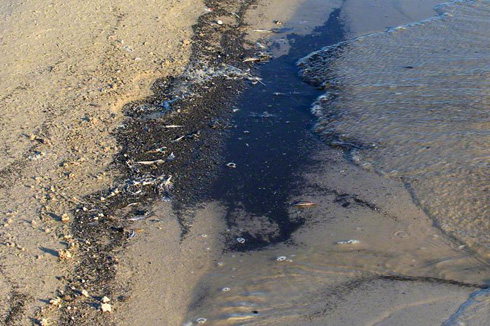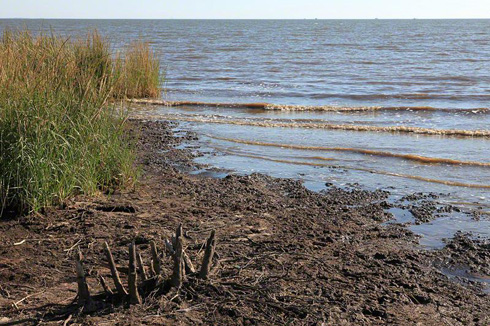The Tragic State of the Gulf of Mexico: Sampling Reveals Oil and Dispersants on Mississippi Coast
In October 2010, Truthout tested several water and soil samples from the Gulf of Mexico for chemicals in BP’s crude oil and toxic dispersants. One sample of dead marine life was also tested.
Truthout also obtained and had analyzed a sample of pure Corexit 9500, one of the toxic dispersants used to sink the crude oil. The dispersants BP has used in the Gulf of Mexico are banned in at least 19 other countries. BP has used at least 1.9 million gallons of the dispersants in the Gulf of Mexico to sink their 4.9 million barrels of crude oil.
The samples were tested in a private lab via gas chromatography by an analyst who requested anonymity.

Pass Christian Harbor at dusk. (Photo: Erika Blumenfeld)
Lab tests have confirmed oil and chemicals from the dispersants in the samples tested, which contradicts ongoing statements from both BP and the Obama administration that the Gulf of Mexico is safe from the effects of the BP oil disaster.
Corexit 9500

Lab tests with Corexit 9500, oil, and saltwater. (Photo: Scientist who performed lab analysis)
These two vials were filled with saltwater and a small amount of motor oil. Two drops of Corexit 9500 were added to the vial on the left and both vials were gently shaken for 30 seconds. Both samples then sat for one hour before this picture was taken.
The milky color of the water in the vial on the left displays the manner in which the dispersant causes a portion of the oil to dissolve into the water. When crude oil in the Gulf is treated with dispersant, a large portion of the oil is also dissolved into the seawater, allowing harmful volatile contaminants to also dissolve into the water, which would have otherwise evaporated had the oil been sitting on the surface.
This theory is nothing new, but this picture displays this phenomenon visually. After nine days, there was still no sign of any separation between the dissolved oil and water at all. In fact, it currently appears that the effect has only increased over time.
The foam atop the vial containing the dispersed oil resembles foam that this writer, other journalists, BP cleanup workers and fishermen along the Gulf Coast have witnessed present in the wake of areas of oil having been sprayed with dispersants.
Many of the chemicals present in the oil and dispersants are known to cause headaches; nausea; vomiting; kidney damage; altered renal functions; irritation of the digestive tract; lung damage; burning pain in the nose and throat; coughing; pulmonary edema; cancer; lack of muscle coordination; dizziness; confusion; irritation of the skin, eyes, nose, and throat; difficulty breathing; delayed reaction time; memory difficulties; stomach discomfort; liver and kidney damage; unconsciousness; tiredness/lethargy; irritation of the upper respiratory tract; and hematological disorders.
Solid Samples
Mississippi Gov. Hailey Barbour has claimed that Mississippi coastal waters are clear, the beaches clean and that the seafood caught in the Gulf is safe to eat.
Yet, soil samples taken along the beach at Long Beach, Mississippi, on October 21, 2010, confirmed the presence of crude oil. One sand sample, from location 3012.45N, 8930.41W, contained 9.35 parts per million (ppm) of Oil Range Organic Petroleum Hydrocarbons (ORO), confirming the presence of crude oil. This sample also contained ethanol, which is a chemical in BP’s dispersants.
Another sand sample taken from the same area contained 160 ppm ORO.
Samples with no oil or chemicals should test at 0 ppm.

Foamy substance at Long Beach, Mississippi that contains oil and ethylene glycol. (Photo: Erika Blumenfeld)
A third sample from the area, containing both sand and a brownish foam on the water that local residents and fishermen believe is the result of dispersed oil, contained 14.68 ppm ORO, confirming the presence of crude oil. This sample also contained ethylene glycol, a chemical in the dispersants.
The US Coast Guard, federal government and BP claim that no dispersants have been used since mid-July.

Black granular material at Long Beach, Mississippi that tested positive for crude oil. (Photo: Erika Blumenfeld)
Another sample from the area taken from sand covered in what local residents described as “coffee grounds” contained 8.65 ppm ORO, confirming the presence of crude oil.
Don’t miss a beat – get Truthout Daily Email Updates. Click here to sign up for free.
A small inlet on the beach was filled with brown foam and oil sheen. A sample of sand covered with the foamy sheen contained 175 ppm ORO.

Foamy substance along shoreline at Long Beach, Mississippi that tested positive for crude oil. (Photo: Erika Blumenfeld)
On January 7, federal and Louisiana officials took a boat tour of an area in southern Louisiana that remains fouled with oil from the BP disaster. They found areas in Barataria Bay where oil continued to eat away at the fragile marshland, where no protective boom nor cleanup workers could be found. Affected areas were up to 100 feet wide in some sections.
“This is the biggest cover-up in the history of America,” Plaquemines Parish President Billy Nungesser told reporters.
Nungesser was angered by claims by the Coast Guard and National Oceanic and Atmospheric Administration (NOAA) officials he was with, who said a plan was being developed to clean the area.
“It’s like you’re in bed with BP,” Nungesser told the officials. “Don’t tell me I got a voice in the way you put together that crappy document,” Nungesser said as WDSU TV filmed the altercation. “It ain’t worth the paper it’s printed on. That is bullshit.” Nungesser then told one of the federal officials, “You cover up for BP.”
Marine Life
A dead jellyfish found on Long Beach, Mississippi, nearby a large amount of the aforementioned thick, brown foam, was tested and found to contain 15 ppm of ethanol, one of the chemicals in the dispersants, along with low levels of n-Butanol, another chemical present in the dispersants that are manufactured by Nalco Holding Company.
Nalco Holding Company has corporate ties to BP.
Based on comparative analysis of Corexit 9500 and the sample collected, the sample appears to contain approximately 500 ppm of dispersant.
Water
A water sample in the same area, taken in an area covered in thick, brown foam, contained propylene glycol, one of the confirmed ingredients of Corexit 9500.
Samples were also taken from a beach in Ocean Springs, Mississippi.

Blood Beach in Ocean Springs, Mississippi. (Photo: Erika Blumenfeld)
A water sample at this area also contained ethelene glycol, as did a water sample taken from a fish pond in the front yard of a resident’s home in Ocean Springs.
Another water sample from the beach contained diethylene glycol BE.

Dead sea turtle, Blood Beach, Ocean Springs, Mississippi. (Photo: Erika Blumenfeld)
Additional Sampling and Conclusions
Earlier this month, Louisiana Environmental Action Network, Lower Mississippi Riverkeeper, in conjunction with the Subra Company, released results of sampling in the coastal regions of Louisiana.
Their press release states:
“The wetlands and ecosystem soil/sediment from Atchafalaya Bay eastward to the Louisiana/Mississippi state line contained 6 to 89 individual Alkylated Polynuclear Aromatic Hydrocarbons (PAHs) and Oil Range Organic Petroleum Hydrocarbons (ORO) up to 11,600 mg/kg [ppm] (1.16%) which corresponded to the fingerprint of the BP Louisiana Sweet Crude.”
Sixty percent of the soil/sediment samples the groups tested contained up to 18 PAHs in excess of the marine sediment screening levels.
The groups tested seafood and found, “Alkylated PAHs were and continue to be detected in aquatic seafood species from the wetlands and estuaries along the Louisiana coast from Atchafalaya Bay eastward to the Louisiana/Mississippi border.”
For example, they found oyster samples with up to 8,815 to 12,500 mg/kg (ppm) ORO, and blue crab samples containing up to 2,230 to 3,583 mg/kg (ppm) ORO.
Shrimp, mussels, fish and snail samples also contained exceedingly high levels of ORO and PAHs.
The press release concluded:
“Wetlands and ecosystem soil/sediment samples and aquatic tissue samples from all areas sampled contained Alkylated PAHs and Oil Range Petroleum Hydrocarbons.”
Mississippi’s Governor Barbour has said that Gulf seafood has been “tested more than any other food in the history of the universe.”
State health departments in Louisiana, Mississippi and Alabama had issued swimming advisories while BP’s well continued to gush oil into the Gulf of Mexico last summer. Since then, however, all three states have declared their beaches, waters and seafood safe from oil disaster related toxins.
Florida never issued any advisories, despite many residents reporting illnesses they attribute to the oil disaster.
US federal government agencies like the Environmental Protection Agency, Food and Drug Administration and the NOAA ,along with President Barack Obama himself, have declared the Gulf of Mexico, its waters, beaches and seafood, safe and open to the public.
The testing conducted on the samples taken by this writer only represent a tiny part of the Gulf compared to the massive area that has been affected by BP’s oil catastrophe. A comprehensive sampling regime across the Gulf, taken regularly over the years ahead by independent scientists, is clearly required in order to implement appropriate cleanup responses and take public safety precautions.

